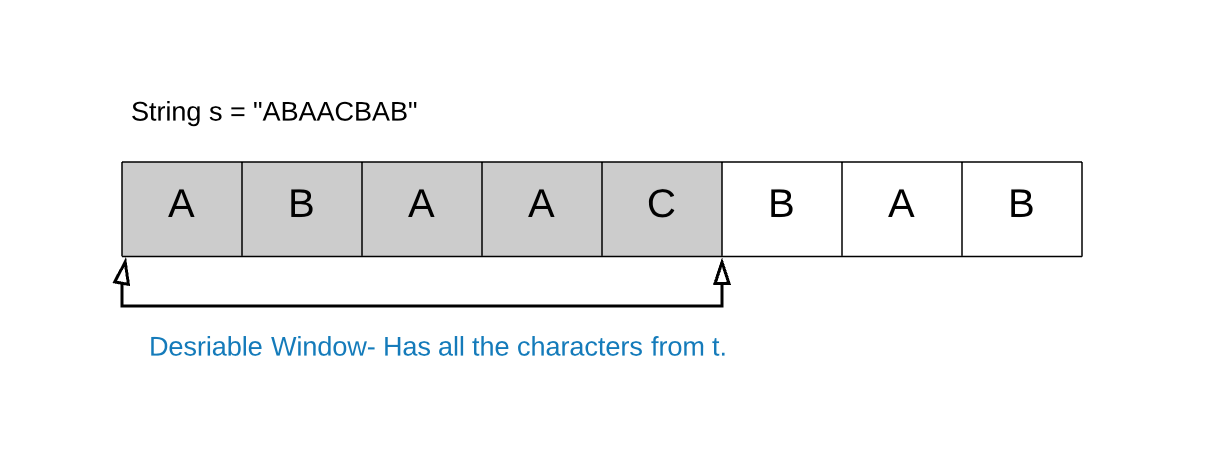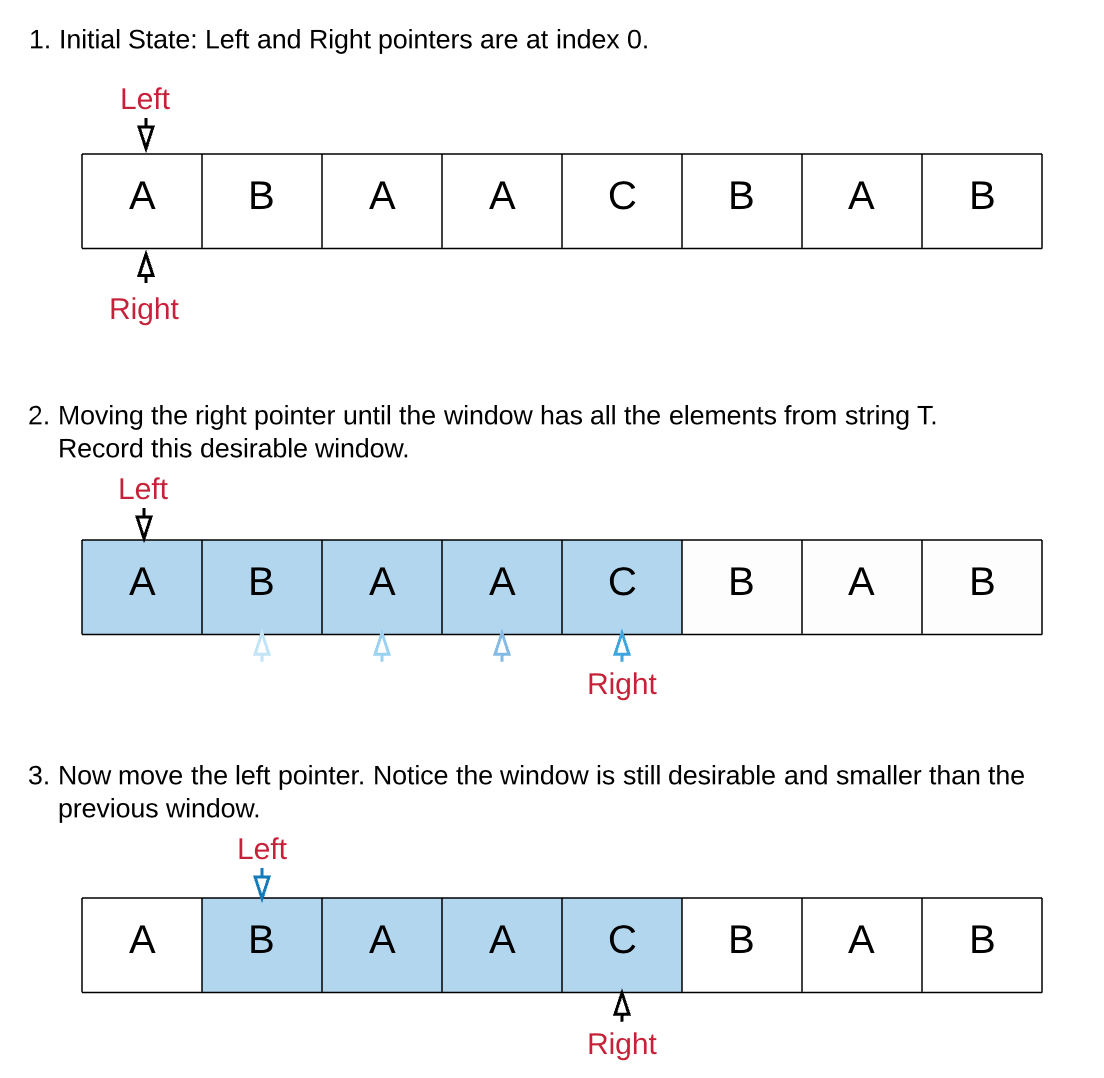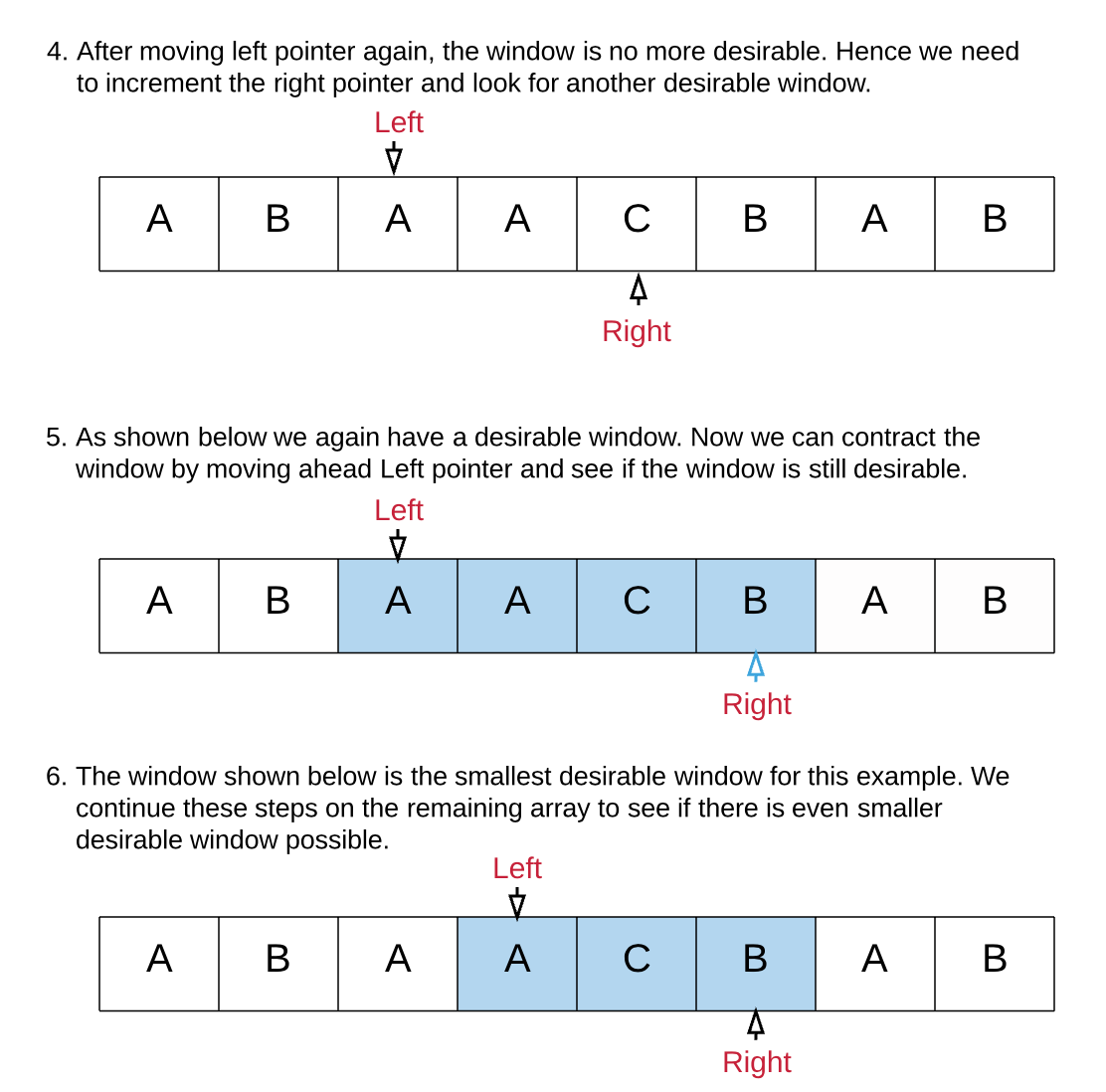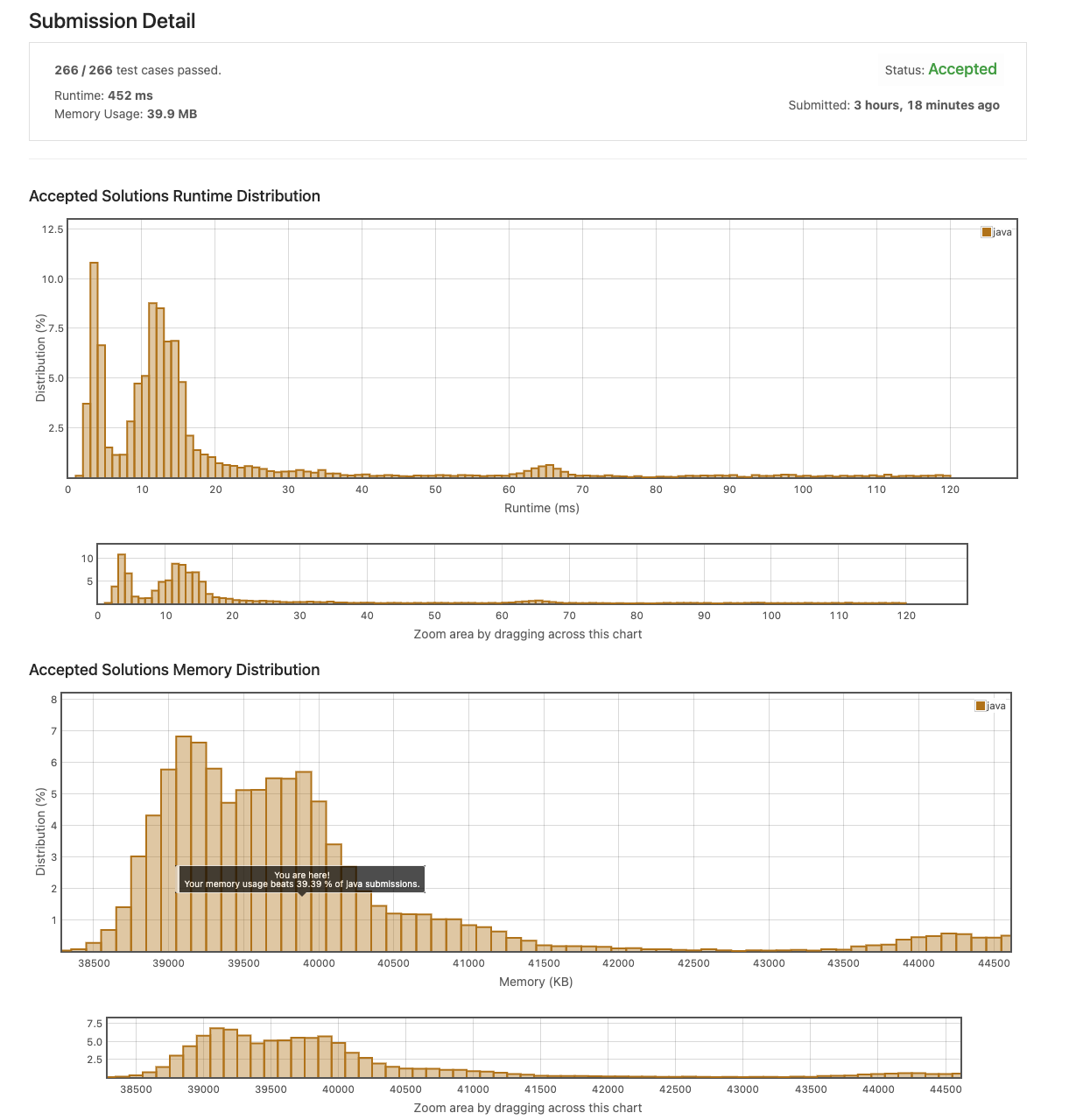Problem
Given two strings s and t of lengths m and n respectively, return the minimum window substring of s such that every character in t (including duplicates) is included in the window. If there is no such substring, return the empty string "".
The testcases will be generated such that the answer is unique.
A substring is a contiguous sequence of characters within the string.
Example 1:
Input: s = "ADOBECODEBANC", t = "ABC" Output: "BANC" Explanation: The minimum window substring "BANC" includes 'A', 'B', and 'C' from string t.Example 2:
Input: s = "a", t = "a" Output: "a" Explanation: The entire string s is the minimum window.Example 3:
Input: s = "a", t = "aa" Output: "" Explanation: Both 'a's from t must be included in the window. Since the largest window of s only has one 'a', return empty string.Constraints:
・ m == s.length ・ n == t.length ・ 1 <= m, n <= 105 ・ s and t consist of uppercase and lowercase English letters.Follow up: Could you find an algorithm that runs in O(m + n) time?
Idea
substring이 주제인 문제는 상당히 어려운 경우가 많다. Minimun Window Substring도 만만치 않은 문제다. t string에 들어있는 모든 문자가 포함된 s의 substring 중 가장 짧은 string의 길이는 얼마인지 구하는 문제다. 문제를 풀긴 했는데 너무 복잡하게 풀어서 다른 사람의 풀이를 봐야겠다는 생각이 든다.
풀이의 기본은 t string에 포함된 문자의 빈도수를 계산하고, s string을 탐색하면서 frequency를 이용해 t string의 모든 문자를 포함한 substring을 구하는 것이다. substring을 구한 뒤 이전에 구한 substring 길이의 최소값과 비교하면서 s string을 끝까지 탐색한다. 알고리즘은 다음과 같다.
- t string의 빈도수를 문자별로 저장한다. 이 때 확인된 문자의 수도 저장한다.
- s string을 탐색한다.
a. t string에 포함되지 않은 문자라면 skip한다.
b. 각 문자의 index를 저장하는 list를 사용한다. list의 크기는 계산한 빈도수이며, list가 꽉 찼을 경우 가장 앞의 index를 제거한다. 제거한 index가 substring의 첫번째 index라면, 첫번째 index를 다음 index로 바꿔준다.
c. substring의 index는 prioiry queue로 관리한다. t string에 포함된 문자가 발견될 경우 해당 priority queue에 넣으며 각 문자의 index를 저장하는 list가 가득 찰 경우, 해당 list의 첫번째 index가 priority queue에서도 제거된다.
d. 새로 발견된 substring의 길이를 측정하여 최소값과 비교한다. 최소값이 변경될 경우 substring의 첫번째 index와 마지막 index를 저장한다.- string s가 string t에 있는 모든 문자를 포함하지 않을 경우 빈 string을 리턴한다.
- 저장한 index를 이용해 결과를 리턴한다.
Sliding Window라는 특성을 이용해 left pointer와 right pointer를 사용하는 방법이 훨씬 뛰어나다.



Solution
class Solution { public String minWindow(String s, String t) { // 1. Measure frequency of each characters in string t int[] freqInT = new int[58]; int[] freqInS; Arrays.fill(freqInT, -1); int charCnt = 0; for (char c : t.toCharArray()) { if (freqInT['z' - c] == -1) { charCnt++; freqInT['z' - c] = 0; } freqInT['z' - c]++; } freqInS = freqInT.clone(); PriorityQueue<Integer> pq = new PriorityQueue<>(); Map<Character, List<Integer>> indexes = new HashMap(); for (char c='A'; c <='Z'; c++) indexes.put(c, new ArrayList()); for (char c='a'; c <= 'z'; c++) indexes.put(c, new ArrayList()); int min = 0; int max = 0; int len = Integer.MAX_VALUE; int minIndex = 0; int maxIndex = 0; for (int i=0; i < s.length(); i++) { // 2. Confirm all characters in string t appear int frequency = freqInT['z' - s.charAt(i)]; if (frequency < 0) continue; if (frequency > 0) { freqInS['z' - s.charAt(i)]--; if (freqInS['z' - s.charAt(i)] == 0) charCnt--; } // 3. Determine minimum index of substring which contains all characters in string t List<Integer> indexList = indexes.get(s.charAt(i)); int front = -1; if (indexList.size() >= freqInT['z' - s.charAt(i)]) { front = indexList.remove(0); } indexList.add(i); pq.add(i); min = pq.peek(); if (front == min) { pq.poll(); if (!pq.isEmpty()) min = pq.peek(); } else { pq.remove(front); } // 4. change index and measure min length of substring max = i; if (charCnt != 0) continue; if (len > max - min) { len = max - min; minIndex = min; maxIndex = max; } } if (charCnt != 0) return ""; return s.substring(minIndex, maxIndex+1); } }결과는 최악...
leetcode에서 제안한 solution은 다음과 같다.
class Solution { public String minWindow(String s, String t) { if (s.length() == 0 || t.length() == 0) { return ""; } // Dictionary which keeps a count of all the unique characters in t. Map<Character, Integer> dictT = new HashMap<Character, Integer>(); for (int i = 0; i < t.length(); i++) { int count = dictT.getOrDefault(t.charAt(i), 0); dictT.put(t.charAt(i), count + 1); } // Number of unique characters in t, which need to be present in the desired window. int required = dictT.size(); // Left and Right pointer int l = 0, r = 0; // formed is used to keep track of how many unique characters in t // are present in the current window in its desired frequency. // e.g. if t is "AABC" then the window must have two A's, one B and one C. // Thus formed would be = 3 when all these conditions are met. int formed = 0; // Dictionary which keeps a count of all the unique characters in the current window. Map<Character, Integer> windowCounts = new HashMap<Character, Integer>(); // ans list of the form (window length, left, right) int[] ans = {-1, 0, 0}; while (r < s.length()) { // Add one character from the right to the window char c = s.charAt(r); int count = windowCounts.getOrDefault(c, 0); windowCounts.put(c, count + 1); // If the frequency of the current character added equals to the // desired count in t then increment the formed count by 1. if (dictT.containsKey(c) && windowCounts.get(c).intValue() == dictT.get(c).intValue()) { formed++; } // Try and contract the window till the point where it ceases to be 'desirable'. while (l <= r && formed == required) { c = s.charAt(l); // Save the smallest window until now. if (ans[0] == -1 || r - l + 1 < ans[0]) { ans[0] = r - l + 1; ans[1] = l; ans[2] = r; } // The character at the position pointed by the // `Left` pointer is no longer a part of the window. windowCounts.put(c, windowCounts.get(c) - 1); if (dictT.containsKey(c) && windowCounts.get(c).intValue() < dictT.get(c).intValue()) { formed--; } // Move the left pointer ahead, this would help to look for a new window. l++; } // Keep expanding the window once we are done contracting. r++; } return ans[0] == -1 ? "" : s.substring(ans[1], ans[2] + 1); } }

